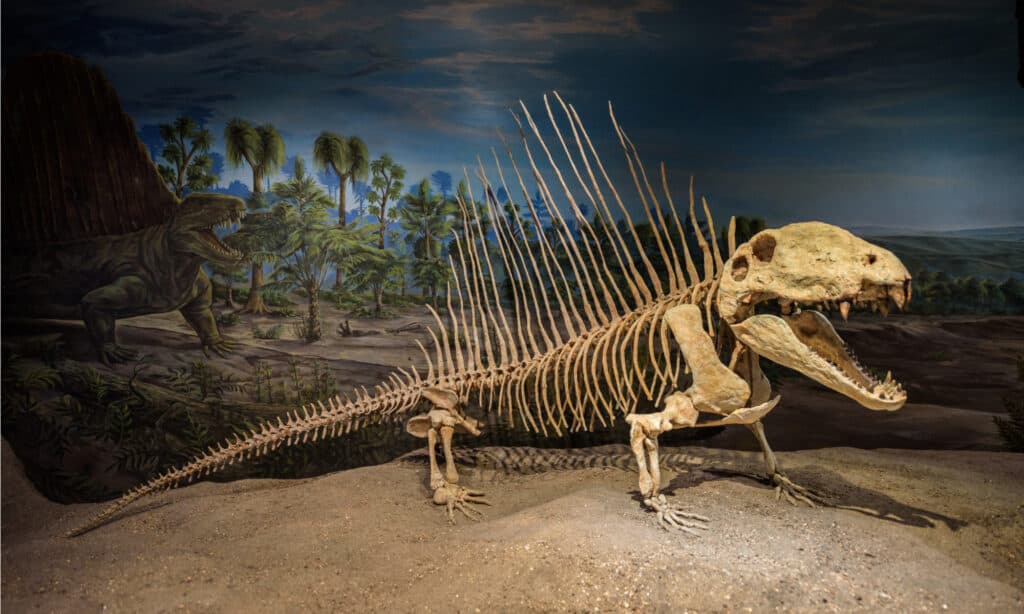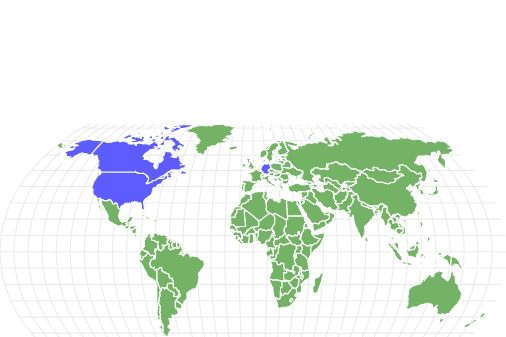Dimetrodon
Dimetrodon limbatus
Dimetrodon was among the largest predators of the Early Permian Period.
Advertisement
Dimetrodon Scientific Classification
- Kingdom
- Animalia
- Phylum
- Chordata
- Family
- Sphenacodontidae
- Genus
- Dimetrodon
- Scientific Name
- Dimetrodon limbatus
Read our Complete Guide to Classification of Animals.
Dimetrodon Conservation Status
Dimetrodon Facts
- Prey
- Fish and other amphibians
- Name Of Young
- larvae
- Fun Fact
- Dimetrodon was among the largest predators of the Early Permian Period.
- Most Distinctive Feature
- Dimetrodon had a massive sail on its back
- Distinctive Feature
- Dimetrodon had a large skull opening behind the eyes
- Habitat
- Swampy areas, scrublands and muddy water
- Diet
- Carnivore
- Special Features
- They had giant sails for thermoregulations
- Origin
- North America
Dimetrodon Physical Characteristics
- Weight
- 60–550 pounds
- Height
- 13 feet
- Length
- 6–15 feet
- Venomous
- No
- Aggression
- Low
View all of the Dimetrodon images!
Dimetrodon is an extinct, mammal-like animal that lived during the Early Permian Period, around 295–272 million years ago. Several ancient animal fossils have been discovered in the southwestern part of the US. Although it is commonly mistaken for a dinosaur, the Dimetrodon is older than the earliest dinosaurs by about 40 million years. Dimetrodon was an apex predator known for the prominent spine sail on its back which was used for balance and thermal regulation.
Description and Size

Beautifully preserved skeleton of a Dimetrodon at the Dinosaurs exhibits of the Royal Tyrrel Museum of Palaeontology in Alberta. The two types of teeth, shearing teeth, and sharp canine teeth can be seen clearly.
©Nick Fox/Shutterstock.com
The name Dimetrodon means “two measures of teeth.” This name is for the famous American paleontologist Edward Drinker Cope. He first used the term “Dimetrodon” in 1878 in an article for the Proceedings of the American Philosophical Society. There are no less than fifteen species of Dimetrodon, one-third of which gor their name from Cope himself. Edward Cope gave Dimetrodon its name because it was the first terrestrial animal to have ziphodont teeth with serrated edges. As different species evolved, the teeth differed.
The most prominent feature of Dimetrodon was undoubtedly its large sail. The sail projects outwards from its vertebrae and forms by an extended neural spines entwined by a membrane of several blood vessels. Scientists believe that the iconic sail is mainly for temperature regulation. Other researchers doubt this is true, considering the Sphenacodon—a close relative of Dimetrodon that also existed during the Early Permian—had no sail.
The skull features were among the most distinctive features that distinguished Dimetrodon from most of the earliest sauropods. Dimetrodon had a high and laterally-compressed skull. The beast had incisor-like front teeth, a large canine tooth with a row of smaller teeth behind the canine. The teeth and large skull openings behind the eye were instrumental in helping paleontologists understand and recognize the animal better. This opening is the temporal fenestrae.
The average Dimetrodon size ranged between six and 11 feet, with an estimated weight of 60–400 pounds. However, the most prominent member of this genus (D. angelensis) was slightly larger than fifteen feet and weighed about 550 pounds. Dimetrodon was sexually dimorphic, which means the males were larger than the females.
Diet—What Did Dimetrodon Eat?
Dimetrodon was carnivorous and largely preferred to feed on fish and other amphibians. Scientists deduced this diet from cross-examining and comparing teeth from three different Dimetrodon species. The discovered differences in size and dentition mean that it evolved over time to hunt larger prey.
The Dimetrodon’s regular prey evolved into larger sizes over time as there were several large carnivores to contend with. To keep up, Dimetrodon also had to grow bigger to hunt larger prey within its ecosystem. The sharp canines in the front of its snout were perfect for digging into freshly-killed prey. Teeth at the back were mostly for shearing bones and grinding tough muscles.
Habitat—Where and When Dimetrodon Lived
Dimetrodon lived during the Permian Period from about 286 million to 270 million years ago. Fossils finds in various locations across North America, including Texas, Oklahoma, Nova Scotia, and Canada. Finds are also in Germany and other European countries. These regions represent an area known as Euramerica during the Permian.
Scientists believe this animal was adaptable to a wide range of habitats, including dry arid lands, swampy areas, scrublands, muddy waters, and vegetative areas. However, most of the fossil finds were in lowland ecosystems that were probably wetlands during the Permian. Dimetrodon is cold-blooded like most modern-day reptiles and walks on four legs, moving mostly like contemporary crocodiles. However, it is classified as a synapsid, meaning it is more closely related to mammals than reptiles.
Threats and Predators
Dimetrodon was an apex carnivorous predator, largely hunting amphibians and tetrapods, tearing them apart with its large teeth. For a long time, it was the most dominant carnivore predator in its native environment until bigger therapsids superseded it. Its ability to regulate its body temperatures gave it a hunting advantage in the morning while other creatures were still groggy.
Dimetrodon repeatedly preyed more on organisms like Diadectes and Euryops. They also ate giant salamanders. Dimetrodon was at the top of the food chain and didn’t have to defend itself against predators. The sail on its back was more for display during the mating season rather than a defense mechanism. The sail is made of soft tissues rather than strong muscles. This has led scientists to conclude that Dimetrodon would not have stood a chance if it had lived in the time of actual dinosaurs.
Discovery and Fossils
The first set of Dimetrodon fossils was discovered in the 1800s. Credit for the earliest discoveries is for Donald Mcleod, who lived in the British colony of Prince Edward Island in 1845. Mcleod recovered a maxilla which he sold to John William Johnson, a Canadian geologist. This particular find in 1854 is the mandible of Bathygnathus borealis—a carnivore related to Thecodontosaurus. In 2015, modern paleontologists reclassified it as Dimetrodon. This was also the first Dimetrodon jaw with ziphodont teeth discovered in Canada.
Most of this animal’s fossils were discovered in a geological deposit known as the Red Beds in Texas and Oklahoma. Edward Drinker Cope was the first to publish an official description of this animal. Cope obtained the fossil he used for his description and those of many other Permian tetrapods from several collectors who had been exploring the famous red beds in Texas.
More recently, fossil discoveries were made at a site known as Bromacker locality in Germany in 2001. Fragmentary remains like this have been found all over Europe. However, Dimetrodon fossils are most prominent in US cities such as Utah, Oklahoma, Texas, Arizona, and Ohio. These areas were part of the Euramerica Supercontinent during the early Permian.
The first specimen of the Dimetrodon with a tail was found in Texas in 1927. The fossil found revealed that the tail formed a large portion of this animal’s total body length. There is no fossil evidence yet that depicts its skin. However, fossil evidence from Ascendonanus shows that Dimetrodon might have had scales like modern reptiles.
Extinction—When Did It Die Out?
They went extinct by the end of the Permian Period because of a phenomenon widely described as the Great Dying or the Permian extinction event. The Great Dying was a disastrous event caused by the warming of the earth’s climate. This triggered changes in the oceans and other ecological changes. The event wiped out over 90% of dinosaur species and 97% of all lives on earth, including land and ocean species.
Similar Animals to the Dimetrodon
Similar animals to the Dimetrodon include:
- Spinosaurus — Spinosaurus lived in the region now popularly referred to as North Africa during the Cenomanian to upper Turonian stages of the late Cretaceous period. This dinosaur had a sail on its back, just like Dimetrodon. It also had a thick body, and it was a carnivore.
- Edaphosaurus — Edaphosaurus was an herbivore. Like the Dimetrodon, it also had a distinctive sail. This animal lived during the Permian, around the same time as Dimetrodon.
- Anteosaurus — This is a genus of mammal-like reptiles that lived in South Africa during the Permian period. It is one of the largest synapsids to have ever lived.
Related Animals
View all 110 animals that start with DDimetrodon FAQs (Frequently Asked Questions)
When was Dimetrodon alive?
Dimetrodon lived during the Permian. This genus of dinosaurs went extinct towards the end of the Permian Period. It lived between 286 million and 270 million years ago.
How big was the Dimetrodon?
Average sizes were about 11.5 feet, weighing between 60 and 400 pounds, but bigger sizes stood as high as fifteen feet and weighed up to 550 pounds. Size differed according to species. It was the biggest predator of its time.
Are Spinosaurus and Dimetrodon related?
No, they’re not related. Although these two animals are often mistaken for each other because they both had sails, Spinosaurus was a dinosaur, while the Dimetrodon was not. It lived at least 40 million years ahead of the dinosaurs.
Thank you for reading! Have some feedback for us? Contact the AZ Animals editorial team.
Sources
- Earth Archives / Accessed November 11, 2022
- Biology Dictionary / Accessed November 11, 2022
- Wikipedia / Accessed November 11, 2022
- Animals Fandom / Accessed November 11, 2022















